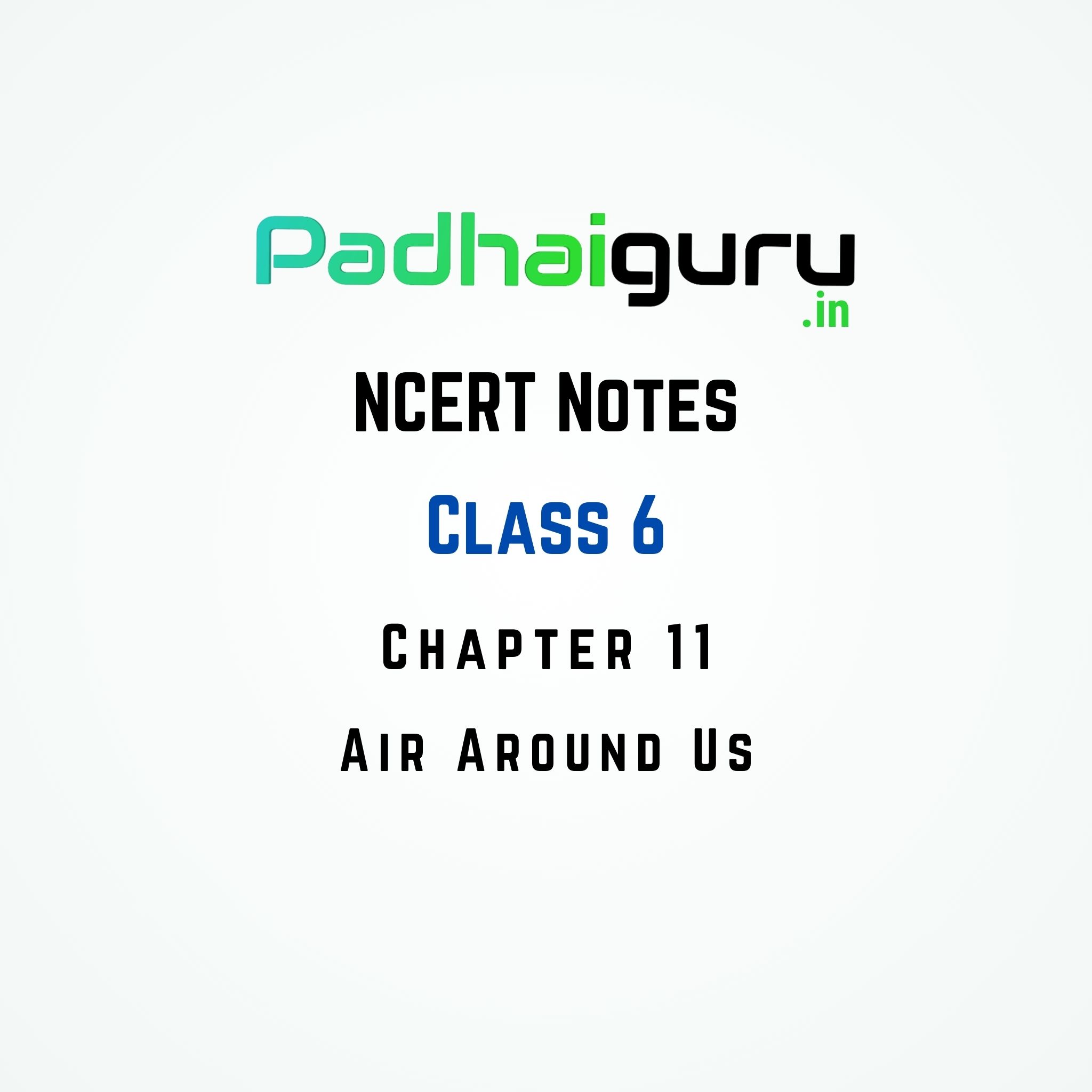11. Air Around Us class 6 NCERT Notes for chapter 11 Science download in pdf

Air Around Us class 6: Exam Notes
Welcome to Air Around Us class 6 NCERT notes Chapter 10 Science NCERT Notes specially created by padhaiguru.in.
Introduction to Air
- Importance of Air for Living Things: All living things require air for survival. While we can’t see air, we can feel its effects in various ways.
- Observable Effects of Air: Air’s presence is evident through rustling leaves, swaying clothes on a clothesline, fluttering book pages due to fan air, flying kites, etc.
Properties of Air
Air in Motion
- Wind Effects: Air in motion is known as wind. It’s responsible for various phenomena, like the rotation of kites and the operation of windmills.

Air’s Occupancy and Transparency
- Air Occupies Space: Demonstrated through an activity involving an empty bottle. Even when inverted, the bottle contains air, which occupies space.
- Invisible but Transparent: Air is colorless and transparent, allowing us to see through it. This transparency enables visibility.

Composition of Air
Components of Air
- Components of Air: Air is a mixture of various gases. The main components include water vapor, oxygen, nitrogen, carbon dioxide, and other trace gases.
- Water Vapor: Contributes to the water cycle and condenses on cool surfaces.
- Oxygen: Supports combustion and is essential for respiration in living organisms.
- Nitrogen: Makes up a significant portion of air and doesn’t support combustion.
- Carbon Dioxide: Present in small amounts; produced by animals and plants and released during burning.
- Dust and Smoke: Particles present in the air due to combustion and industrial processes.

Availability of Oxygen to Organisms
- Dissolved Oxygen: In water, animals utilize dissolved oxygen for respiration.
- Soil Air: Organisms in the soil and plant roots respire using the air present in the soil.
- Importance of Soil Air: Air-filled spaces in soil enable respiration for underground organisms.
Oxygen Replacement in the Atmosphere
- Photosynthesis: Plants produce oxygen through photosynthesis. While they consume oxygen, they produce more than they use.
- Interdependence of Plants and Animals: Oxygen balance in the atmosphere is maintained through the exchange between plants and animals.
Uses and Importance of Air
- Wind Energy: Windmills harness wind energy for various purposes, including drawing water and generating electricity.
- Movement: Air enables movements of yachts, gliders, parachutes, airplanes, birds, bats, and insects.
- Dispersal: Air plays a role in dispersing seeds and pollen, contributing to plant reproduction.
- Water Cycle: Air is a crucial element in the water cycle, facilitating processes like evaporation and condensation.
Keywords and Definitions:
- Wind: Air in motion.
- Photosynthesis: The process by which plants convert sunlight into energy, producing oxygen as a byproduct.
- Respiration: The process of exchanging gases, usually referring to oxygen intake and carbon dioxide release in living organisms.
- Combustion: The chemical reaction of a substance with oxygen, often accompanied by the release of heat and light.
Frequently Asked Questions (FAQs):
Q1: What is the significance of air in our daily lives?
A1: Air is essential for various reasons, including supporting life through respiration, enabling movements, and playing a role in natural processes like the water cycle.
Q2: How does air occupy space?
A2: An activity involving an inverted bottle submerged in water demonstrates that air occupies space as bubbles escape when the bottle is tilted.
Q3: What are the primary components of air?
A3: Air is a mixture of gases, primarily including nitrogen, oxygen, water vapor, carbon dioxide, and trace gases.
Q4: How does oxygen become available to aquatic animals?
A4: Aquatic animals utilize dissolved oxygen in water for respiration, which they extract from the surrounding water.
Q5: Why do plants and animals rely on each other for oxygen exchange?
A5: Plants produce oxygen through photosynthesis, which animals use for respiration. In return, animals produce carbon dioxide, which plants use for photosynthesis.
Q6: What is the role of windmills?
A6: Windmills harness wind energy to perform various tasks, such as pumping water and generating electricity.
Q7: How does air contribute to seed dispersal?
A7: Air helps disperse seeds by carrying them away from the parent plant, increasing the chances of new plant growth.
Q8: How does combustion affect the air?
A8: Combustion releases gases and particles into the air, contributing to air pollution and environmental impact.
Q9: Why do mountaineers carry oxygen cylinders?
A9: As altitude increases, the air becomes thinner and contains less oxygen. Mountaineers carry oxygen cylinders to ensure a sufficient supply of oxygen at high altitudes.
Q10: What role does air play in the water cycle?
A10: Air facilitates the water cycle by enabling processes like evaporation, condensation, and precipitation.
This was the end of ncert notes on air around us class 6 chapter 11 science.
For more information, refer to NCERT SOLUTIONS, NCERT NOTES, and NCERT BOOKS
